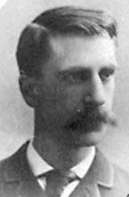Nathan Abbott
Nathan D. Abbott (11 July 1854 – 4 January 1941) was an American lawyer from the U.S. State of Maine. He was the co-founder of Stanford Law School, where he also served as its first dean.
Nathan Abbott | |
|---|---|
 | |
| 1st Dean of Stanford Law School | |
| In office 1895–1907 | |
| Succeeded by | Charles Huberich |
| Personal details | |
| Born | July 11, 1854 Norridgewock, Maine |
| Died | January 4, 1941 (aged 86) |
| Spouse(s) | Frances Abbott (née Field)
( m. 1884; died 1924) |
| Children | 2 |
| Parents | Abdiel Abbot Sarah Smith Abbott (née Davis) |
| Education | Yale College (B.A.) Boston University School of Law (LL.B.) |
Personal life and education
Abbott was born in Norridgewock, Maine, the son of Abiel Abbott and Sarah Smith Abbot on 11 July 1854. He studied in Norridgewock public schools until the age of 16. That year, in 1870, he moved to Andover, Massachusetts to study at Phillips Academy. After three years there, in 1873 he was admitted and studied at Yale College, where he graduated with a Bachelor of Arts in 1877.[1] At Yale, he was a member of Scroll and Key secret society and Psi Upsilon fraternity.[2]
His legal education consisted of a mixture of reading law at his father's practice in Boston as well as attending Boston University School of Law. He graduated from the latter in 1883 with a Bachelor of Laws (LL.B.). On April 23, 1884 he married his wife, Frances Field.[1][3]
Career
Abbot practiced law in Boston for about seven years until 1891, when he accepted a position to teach law at the University of Michigan, but held the position for only one year when he resigned to accept a professorship of law in Northwestern University.[1][4]
After teaching at Northwestern for just two years, in 1895 Abbot was asked to form a Department of Law at Stanford University by its then President, David Starr Jordan. Upon his arrival, Stanford was suffering widespread financial cuts and layoffs as a result of a dispute over the finances of Leland Stanford's estate as well as the economic fallout from the Panic of 1893. Abbot was forced to perform a wide array of unusual duties to begin work on his new law school, including building furniture for the school himself. The law school grew quickly during its formative years, reaching 100 students by the turn of the millennium.[4][5] The department was also unique in that it accepted students regardless of race or gender; Abbot accepted students who were Hispanic, Chinese, Japanese, and female.[5][6]
Abbot was a personal friend to famous philosopher William James, who, in fact, was visiting in Abbot's home during the 1906 San Francisco earthquake.[4][5]
He held that position until 1907, after which time he was a member of the law faculty of Columbia University, New York City. He was a legal scholar of wide reputation and a recognized authority on the English and American Law of Real Property.[7][8]
Abbot retired in 1922 around the age of 68. He died in 1941 due to complications from Pyelonephritis.[3][4]
References
- "Nathan Abbott". www.law.umich.edu. Retrieved 2020-04-29.
- The Yale Banner. 1876.
- "Nathan Davis Abbott (1854-1941) - Find A Grave..." www.findagrave.com. Retrieved 2020-04-29.
- School, Stanford Law. "Nathan Abbott: A Man No Different from Today's Law Professor… In Some Ways". Stanford Law School. Retrieved 2020-04-29.
- School, Stanford Law. "The Early Years". Stanford Law School. Retrieved 2020-04-29.
- Michigan, University of (1902). General Catalogue of Officers and Students, 1837-1901. The University. p. 14.
- Hinsdale, Burke Aaron (2016). History of the University of Michigan. University of Michigan. ISBN 1359050337.
- Oskison, John Milton (2012). Tales of the Old Indian Territory and Essays on the Indian Condition. U of Nebraska Press. ISBN 978-0-8032-3792-6.